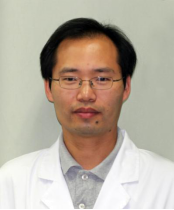
一、基本信息
姓名:荣知立
职称:教授
联系邮箱:rongzhili@smu.edu.cn
二、学习经历
1998.9-2002.7 清华大学,生物科学与技术专业,学士
2002.9-2007.7 清华大学,生物学专业,博士
2007.9-2014.9 美国加州大学圣迭戈分校,博士后,科研助理
三、拟招收博士后开展的研究方向
1. 利用多能干细胞来源类器官和小鼠动物模型,研究肺癌发生发展,以及开发肺损伤细胞治疗方案;
2. 利用多能干细胞来源类器官和小鼠动物模型,研究皮肤淀粉样变和瘢痕疙瘩等皮肤病发病机制;
3. CRISPR/Cas9基因编辑技术的开发和应用。
四、主要获奖情况
1. 2015年,入选海外高层次人才引进计划,青年项目,中央组织部
五、代表性论文
1. Deng, C.C., Zhu, D.H., Chen, Y.J., Huang, T.Y., Peng, Y., Liu, S.Y., Lu, P., Xue, Y.H., Xu, Y.P., Yang, B.* & Rong, Z.* TRAF4 promotes fibroblast proliferation in keloids by destabilizing p53 via interacting with the deubiquitinase USP10. J Invest Dermatol 139, 1925-1935 (2019).
2. Zhang, X., Wang, W., Shan, L., Han, L., Ma, S., Zhang, Y., Hao, B., Lin, Y.* & Rong, Z.* Gene activation in human cells using CRISPR/Cpf1-p300 and CRISPR/Cpf1-SunTag systems. Protein & cell 9, 380-383 (2018).
3. Ma, S., Lv, J., Sun, J., Tang, P., Li, H., Zhou, H., Zhang, Z., Lin, Y.* & Rong, Z.* iKA-CRISPR hESCs for inducible and multiplex orthogonal gene knockout and activation. FEBS letters 592, 2238-2247 (2018).
4. Chen, Y., Feng, J., Zhao, S., Han, L., Yang, H., Lin, Y.* & Rong, Z.* Long-Term Engraftment Promotes Differentiation of Alveolar Epithelial Cells from Human Embryonic Stem Cell Derived Lung Organoids. Stem cells and development 27, 1339-1349 (2018). (Cover story)
5. Ye, H., Rong, Z.* & Lin, Y.* Live cell imaging of genomic loci using dCas9-SunTag system and a bright fluorescent protein. Protein & cell 8, 853-855 (2017).
6. Wang, R.M., Johnson, T.D., He, J., Rong, Z., Wong, M., Nigam, V., Behfar, A., Xu, Y. & Christman, K.L. Humanized mouse model for assessing the human immune response to xenogeneic and allogeneic decellularized biomaterials. Biomaterials 129, 98-110 (2017).
7. He, J., Rong, Z., Fu, X. & Xu, Y. A Safety Checkpoint to Eliminate Cancer Risk of the Immune Evasive Cells Derived from Human Embryonic Stem Cells. Stem cells 35, 1154-1161 (2017).
8. Zhao, T., Zhang, Z.N., Westenskow, P.D., Todorova, D., Hu, Z., Lin, T., Rong, Z., Kim, J., He, J., Wang, M., Clegg, D.O., Yang, Y.G., Zhang, K., Friedlander, M. & Xu, Y. Humanized Mice Reveal Differential Immunogenicity of Cells Derived from Autologous Induced Pluripotent Stem Cells. Cell stem cell 17, 353-359 (2015).
9. Rong, Z., Zhu, S., Xu, Y. & Fu, X. Homologous recombination in human embryonic stem cells using CRISPR/Cas9 nickase and a long DNA donor template. Protein & cell 5, 258-260 (2014).
10. Rong, Z., Wang, M., Hu, Z., Stradner, M., Zhu, S., Kong, H., Yi, H., Goldrath, A., Yang, Y.G., Xu, Y. & Fu, X. An effective approach to prevent immune rejection of human ESC-derived allografts. Cell stem cell 14, 121-130 (2014).
Commented by Cell Stem Cell (Cell Stem Cell 14: 3)
Reported by Fox News, China Daily, Science Daily, Medical news today, and UT San Diego et al.
11. Fu, X.#, Rong, Z.#, Zhu, S., Wang, X., Xu, Y. & Lake, B.B. Genetic approach to track neural cell fate decisions using human embryonic stem cells. Protein & cell 5, 69-79 (2014).
12. Rong, Z.#, Fu, X.#, Wang, M. & Xu, Y. A scalable approach to prevent teratoma formation of human embryonic stem cells. J Biol Chem 287, 32338-32345 (2012).
13. Zhao, T., Zhang, Z.N., Rong, Z. & Xu, Y. Immunogenicity of induced pluripotent stem cells. Nature 474, 212-215 (2011).
Highlighted by Nature (Nature 474:165); Nature Medicine (Nature Medicine 17: 670)
Recommended by Faculty of 1000 (F1000.com/11136956)
Reported by Nature, Science, New York Time, New Scientist, Science Daily, The Guardian (UK), USA today et al.
14. Rong, Z., Wang, A., Li, Z., Ren, Y., Cheng, L., Li, Y., Wang, Y., Ren, F., Zhang, X., Hu, J. & Chang, Z. IL-17RD (Sef or IL-17RLM) interacts with IL-17 receptor and mediates IL-17 signaling. Cell Res 19, 208-215 (2009).
15. Rong, Z., Ren, Y., Cheng, L., Li, Z., Li, Y., Sun, Y., Li, H., Xiong, S. & Chang, Z. Sef-S, an alternative splice isoform of sef gene, inhibits NIH3T3 cell proliferation via a mitogen-activated protein kinases p42 and p44 (ERK1/2)-independent mechanism. Cell Signal 19, 93-102 (2007).
16. Rong, Z., Cheng, L., Ren, Y., Li, Z., Li, Y., Li, X., Li, H., Fu, X.Y. & Chang, Z. Interleukin-17F signaling requires ubiquitination of interleukin-17 receptor via TRAF6. Cell Signal 19, 1514-1520 (2007).